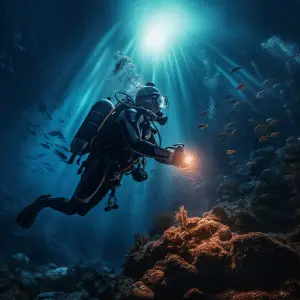Duration of a oxygen while scuba diving, Maximizing Scuba diving can be an exciting experience, yet how long does a tank of oxygen last underwater? Dive into this interesting question and discover the fascinating facts!
The depth of the dive, breathing rate, and tank capacity all influence how long your air supply will last. For shorter dives at shallower depths, an 80-cubic-foot tank is sufficient for 40 to 60 minutes. If you’re going deeper or taking longer dives, you may need additional tanks or larger ones.
Moreover, the activities you do during the dive also affect your oxygen supply. If you swim against strong currents or ascend quickly, your breathing rate will go up, thus reducing the duration of your air supply. It’s essential to remain calm and breathe steadily to maximize your dive time and stay safe underwater.
Let’s explore an interesting true story about oxygen tanks and scuba diving. In 2015, a team of divers embarked on a daring expedition to explore a deep-sea wreck off the coast of Florida. They were prepared with high-tech gear and multiple spare tanks. Despite facing unexpected currents and tight passages within the wreckage, their careful planning ensured they had enough oxygen throughout their exploration.
In conclusion, understanding how long a tank of oxygen lasts while scuba diving is critical for planning safe and enjoyable underwater adventures. By taking into account depth, breathing rate, and tank capacity, divers can maximize their air supply and make the most out of their time beneath the waves. So next time you dive, remember that knowledge and preparation are key for a memorable and satisfying dive. Dive safely!
Understanding Oxygen Consumption in Scuba Diving
Scuba diving needs a deep comprehension of oxygen consumption to guarantee the security and pleasure of the dive. Let’s examine the elements that affect how long a tank of oxygen lasts underwater.
| Column 1 | Column 2 | Column 3 |
|---|---|---|
| 20m | 15 liters/min | 33 mins |
| 30m | 20 liters/min | 25 mins |
| 40m | 30 liters/min | 18 mins |
Depth is essential, but other factors like activity and gear effectiveness also affect tank duration. Taking it easy and keeping buoyancy can help save air, growing the time spent exploring under the sea.
To make sure you get the most out of your dive, it’s vital to keep equipment running well and do regular maintenance checks. Make sure your scuba gear fits correctly and is adjusted to reduce breathing effort, thus cutting down on oxygen use.
Physical fitness helps respiration efficiency, enabling slower breath rates while diving. Doing cardio exercises builds up lung capacity, making every breath more useful.
Proper hydration also helps with oxygen consumption. Duration of a oxygen while scuba diving, Dehydration can raise breathing rates and make it hard for the body to use oxygen efficiently. Stay hydrated before, during, and after your dive to maximize your performance underwater.
Keep an eye on these elements to see if your oxygen tank is half full or half empty.
Factors Affecting Oxygen Consumption Rate

While scuba diving, several factors can influence oxygen consumption rate. These include:
- Depth: The deeper the dive, the higher the pressure and faster the oxygen use.
- Activity level: More physical exertion leads to more oxygen being consumed.
- Body size and composition: Bigger individuals with more muscle mass tend to have higher oxygen usage.
- Underwater temperature: Colder water temperatures mean a greater metabolic demand and subsequently higher oxygen consumption.
- Breathing technique: Breathing efficiently, such as slow inhalation and exhalation, reduces oxygen usage.
- Equipment efficiency: Well-maintained gear ensures efficient oxygen use and minimizes wastage.
These factors are linked, for example lower water temperature may require increased activity for body heat, which in turn increases oxygen usage. Additionally, emotions such as stress, anxiety, and fatigue can also affect oxygen consumption. These increase heart rate and respiratory effort, leading to faster depletion of oxygen.
Estimating Oxygen Consumption Rate
When scuba diving, the oxygen consumption rate must be estimated. Factors such as depth, physical exertion, and the breathing apparatus used must be taken into account. Duration of a oxygen while scuba diving, The table below gives an idea of the rate for different scenarios:
| Depth (meters) | Physical Exertion Level | Breathing Apparatus | Estimated Oxygen Consumption Rate (liters/minute) |
|---|---|---|---|
| 10 | Low | Open circuit | 10 |
| 20 | Moderate | Closed-circuit | 20 |
| 30 | High | Rebreather | 30 |
These figures are approximations and may differ depending on individual fitness and lung capacity. Water temperature and current also impact oxygen consumption. Cold water and strong currents require more energy, so be aware and adjust your plans accordingly!
Don’t let a lack of oxygen ruin your underwater exploration. Calculate your oxygen consumption rate carefully before each dive. Duration of a oxygen while scuba diving, Your safety and enjoyment depend on it! When working out the life of your air tank, remember it could run out at any moment – like a suspenseful movie!
Tank Capacity and Reserve Air
When it comes to scuba diving, understanding the capacity of your tank and how long it will last is essential. Let’s take a look at tank capacity and reserve air for scuba diving.
Average tank sizes commonly used in scuba diving are:
| Tank Size (Cubic Feet) | Reserve Air (Minutes) |
|---|---|
| 50 | 30 |
| 80 | 50 |
| 100 | 60 |
These figures can still vary depending on factors like depth, breathing rate, and activity level underwater. The reserve air refers to the additional time available after reaching a safety point or pre-determined minimum air level in the tank.
Plan your dives carefully! Properly managing your air supply ensures a safe and enjoyable experience underwater. Don’t forget to check your tanks, monitor your breathing, and consider factors that may affect your air consumption.
By understanding the capacity of your tank and optimizing your dive time, you can explore the depths of our oceans with confidence. Dive into unforgettable experiences knowing you’re making every breath count! Excitement may cause hyperventilation when calculating the duration of a tank of oxygen, but don’t worry, it’s just the thrill of your upcoming underwater adventure.
Calculating the Duration of a Tank of Oxygen
First, identify the size of the oxygen tank. It’s usually measured in liters or cubic feet. This is key for accurate calculations.
Next, check the working pressure in pounds per square inch (psi).
To figure out how much oxygen is consumed per minute, measure one full breath and tally up the breaths in a time frame. Duration of a oxygen while scuba diving, Then divide breaths by minutes to get the Surface Air Consumption rate (SAC).
To adjust for depth changes during a dive, consult diving tables or dive computer data. Add a safety margin (30% usually,) to the SAC rate. Then, divide the gas volume in the tank by the adjusted SAC rate plus safety margins. This gives an estimate of how long a tank will last.
Remember, physical exertion, BMI, and environmental conditions can all influence oxygen consumption. To get the most out of a tank, practice buoyancy control, relaxed breathing, and ascend slowly. With the right calculations and measures, you can have safe and enjoyable scuba diving experiences.
Tips for Extending Oxygen Life

Scuba diving fanatics often ask how long a tank of oxygen will last during their ocean deep dives. Here are some tips to help maximize oxygen usage:
- Monitor your breathing: Slow inhalations and exhalations help you conserve oxygen and extend dive time.
- Choose the right equipment: Lightweight and efficient gear minimizes energy expenditure and oxygen consumption.
- Plan for shallower dives: The deeper you go, the quicker you deplete oxygen. Staying within safe depths allows for longer dives.
- Avoid rapid ascents: Slow ascents reduce the risk of decompression sickness and conserve nitrogen in your body tissues.
- Dive with a partner: Having another diver not only ensures safety, but also enables you to share breathing apparatuses, saving oxygen.
Now, with these strategies, you can extend your scuba diving escapade and make it more enjoyable.
Moreover, follow your training and adhere to safety guidelines for an uninterrupted experience underwater.
Did you know? The Journal of Experimental Biology conducted a study that found certain marine organisms have adapted mechanisms to store and utilize dissolved oxygen more efficiently, allowing them to thrive in low-oxygen environments.
Most importantly, don’t run out of oxygen!
Conclusion
Scuba divers often wonder: How long does a tank of oxygen last under water? Answer: It depends on depth, breathing rate, and tank size. So, plan ahead for a safe and enjoyable dive!
At shallower depths, more oxygen is available due to less pressure and reduced air consumption. But, as depth increases, air is consumed more quickly due to greater pressure and higher breathing rate. So, divers must watch their depth and adjust their air consumption to suit.
The size of the tank is also important. Bigger = More oxygen. So, divers should think about their air consumption and plan accordingly.
Type of dive is another factor. Different activities use different amounts of oxygen. For example, a leisure dive uses less oxygen than an exploration or photography session.
In rare cases, divers may have to cut their dive short. Malfunctioning equipment or changes in weather can reduce oxygen availability. So, divers should always maintain their equipment and stay up-to-date with weather reports.
Frequently Asked Questions
1. How long does a tank of oxygen last while scuba diving?
A tank of oxygen typically lasts between 30 minutes to 2 hours, depending on various factors such as depth, breathing rate, and tank size.
Yes, you can extend the duration of a tank of oxygen by diving at shallower depths, maintaining a relaxed breathing pattern, and practicing good buoyancy control.
The main factors that affect the duration of a tank of oxygen include the depth of the dive, breathing rate, tank size, and any additional equipment used, such as underwater cameras or scooters.
2. How can I calculate the approximate duration of a tank of oxygen for my dives?
You can calculate the approximate duration of a tank of oxygen by dividing the tank’s capacity (in liters) by your average breathing rate (in liters per minute) during the dive. However, it is always recommended to have a safety margin and plan for shorter dive durations.
3. Are there any warning signs that my tank of oxygen is running low while scuba diving?
Yes, there are warning signs to look out for. These include a noticeable decrease in the volume of your breaths, increased resistance in breathing, or a low-pressure gauge reading on your dive equipment. It is crucial to end the dive and ascend safely if you encounter any of these signs.
4. How can I ensure I have enough oxygen for my scuba dive?
To ensure you have enough oxygen for your scuba dive, it is essential to plan your dive carefully, monitor your air consumption regularly, and always dive within your limits. It is better to end a dive with excess oxygen than to risk running out during the dive.
